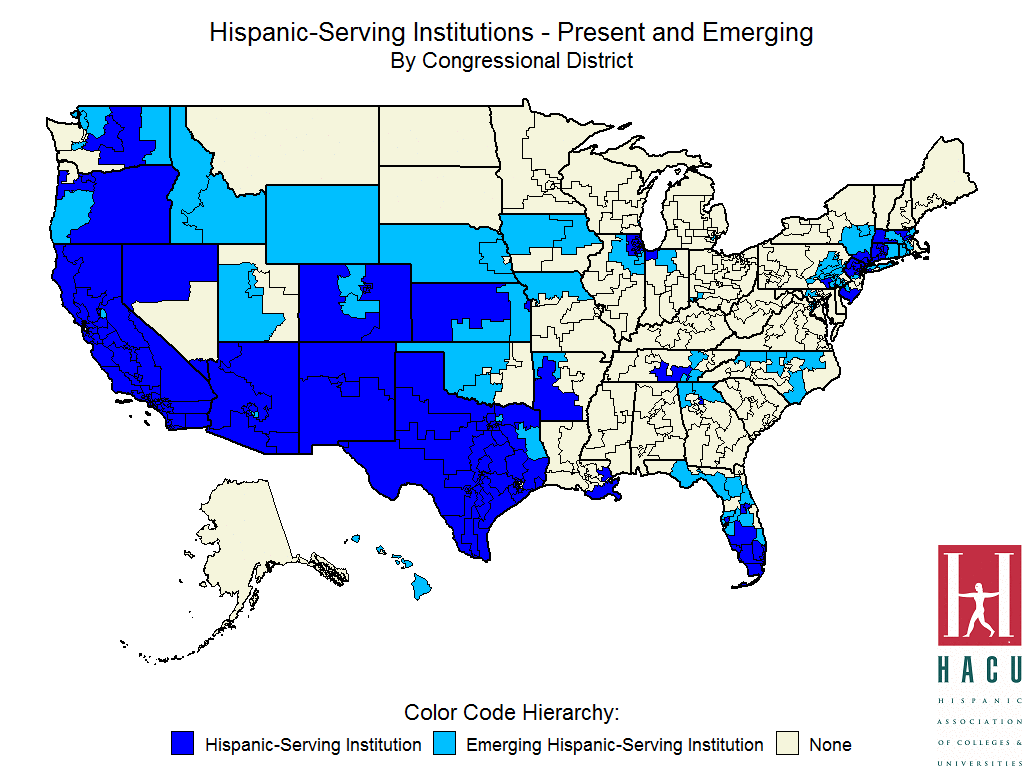Hispanic Educational Resources and Empowerment (HERE) Act of 2023
CALL TO ACTION
Contact your representative to pass the HERE Act (H.R. 5469/S. 2813).
HACU strongly supports the HERE Act since it addresses the lingering achievement gaps among Hispanic students, and the debilitating dynamic of PK-12 and higher education not working together.
Collaboration between HSIs and Hispanic-Serving School Districts (HSSDs)
“We’re determined to get all our students across the finish line in the same amount of time, but we’re not all at the same starting line”, Andrew Hamilton, Associate Dean for Student Success at the University of Houston.
Background
Hispanic students are changing the face of education both in the PK-12 system and throughout higher education. In the 2021-22 school year, there were nearly 3,000 school districts with 25% or more Hispanic enrollment, and they enrolled 80 percent of all kindergarten through grade 12 Hispanic students in the United States or 11.6 million individuals. Represented among these districts are 9 of the Nation’s 10 largest school districts.

Why do we need the HERE Act?
It is clear that the changing demographics in elementary and secondary schools in the U.S., in addition to fueling the rapid growth of HSIs, also present us with new opportunities to address lingering achievement gaps between White and Hispanic students. For example, while HACU is pleased about the considerable progress in recent decades in high school completion and college matriculation rates, it remains concerned that Hispanics still lag non-Hispanic whites in education attainment. Too many Hispanic students still have little or no exposure to higher education opportunities during their early school years. Similarly, HACU acknowledges that more Hispanics are going to college than ever but remains concerned that less than half of them earn a bachelor’s degree. For too many low-income, first generation students, including Hispanics, the preparedness provided by their early education experience is inadequate for success in a post-secondary environment.
In order to address these concerns and others, HACU has partnered with Congressman Joaquin Castro to introduce the HERE Act (H.R. 5469 and Senator Alex Padilla (S. 2813) that focuses on maximizing the collaborative potential of the PK-12 and the higher education systems.
What does the HERE Act do?
The HERE Act proposes a new grant program, authorized at $150 million, under Title V of the Higher Education Act. The program would provide support for several activities between HSIs and school districts, including:
- Creating a college-going culture among eligible students;
- Providing academic support to prepare students for postsecondary education, prevent the need for postsecondary remediation, and, if necessary, provide high quality postsecondary remediation;
- Supporting eligible students through the college application and transition process;
- Addressing non-academic needs that serve as barriers to college enrollment, persistence, and completion.
HACU strongly supports the HERE Act since it addresses the lingering achievement gaps among Hispanic students, and the debilitating dynamic of PK-12 and higher education not working together.
Interactive Map
Click on the image below to view the interactive map that shows the geographic relationship between HSIs-eHSIs and HSSDs-eHSSDs.
Additional Resources
-
Hispanic-Serving School Districts (HSSDs) - Hispanic Student Data (2015-16)
-
Emerging Hispanic-Serving School Districts (eHSSDs) - Hispanic Student Data (2015-16)
Did you know?
The average Hispanic student enrollment is nearly 50% among the Hispanic-Serving School. Districts (HSSDs) in the U.S.

